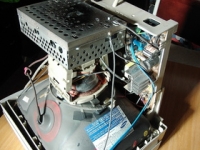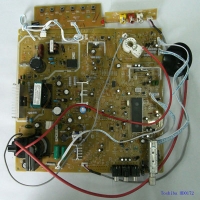 |
|||||||||||||||||||||||||||
|
| |||||||||||||||||||||||||||
|
Home > E-waste recycling articles > Why recyclers stay away from Cathode Ray monitors Why do all recyclers stay away from CRT monitors and TV'sBefore we start with that question which is very important, we will ask ourselves the opposite question? we all know that recycling companies are in business (not charity) for one reason, and it is profits, of course that many recyclers see their work as a mission, however all of them, or most of them need to make a living. Now to the question, lets take a computer CRT (cathode ray tube) monitor for instance and take it apart. This is how the CRT will look after we take out the plastic casings, this will require about 12-20 screws to un-screw. You can actually click on the picture in order to see it in a large view like we do, this computer monitor like all other CRT monitors is made of a few parts: Big glass tube, which is the actual CRT, or its name is Cathode ray tube, this is made in a vacuum technology, the glass is usually leaded which according to the EPA's guidelines it might represent an environmental hazard if not disposed of properly. The EPA actually updated the rule about these back in 2014 see reference here https://www.epa.gov in general this means that CRTs marked for disposal are considered hazardous waste under the Resource Conservation and Recovery Act (RCRA). And must be disposed of properly and actually taken to a certified recycler which will dispose of it properly, this means that in order to dispose of CRTs there are expenses, because such recycler will not dispose of the cathode ray tube for free, since there is almost nothing to recover from it, except for glass and some copper. Another part on the CRT monitor or a TV is the yoke, this part is actually worth money, however, it takes a long time to disassemble it from the actual Cathode ray tube and the plastic since you first have to open all of the screws of the casing of the monitor and than you have to cut all of the wires. Another part of the CRT or TV is the printed circuit board, there is usually 1 circuit board on each monitor or TV or 2 on some types, usually circuit boards do contain precious metals, and there are buyers for PCB who would like to buy these, except for that kind, this circuit board is almost 100% scrap, it contains almost no palladium or silver for recovery, not to mention gold, the main ingredient in that PCB is copper which sells for high $$$ per ton, but again, the recovery of the copper from that circuit board would cost almost the value of it, please see the picture of the PCB out of TV's and CRT's below, you can click on the image in order to see it in a larger view.
Bottom line, if you take a CRT or a TV apart you will probably spend as much in labor as you recover from selling the copper yoke, printed circuit board (s) and the wires, and you will be left with the cathode ray tube which you will have to dispose of properly (if you would like to do the right thing and not just dump it in a landfill), and that will actually cost you money to do. What do recyclers that buys or takes CRT's do with it?In the past recyclers was able to actually export the scrap CRT's and TV's to third world countries such as China, Philippines, India and Malaysia. What did they do with it?Back in 2001 a lot of computer CRT monitors used was exported to these countries, the rumor said that it was there converted from computer monitors into little TV's, yes 14", 15" and 17" TV's, it was explained that since these countries has very crowded cities so apartments there is about 10 square meters or 100 square foot, and they fit not less than 8 people in such a small room, that is why they preferred such a small TV. A fact is that people in these kind of countries such as China for an example worked (some still) for about $50.00 per month, that means that if an employee in a "precious metals refinery" took apart only 10 CRT monitors per day which is more than possible, this means about $0.20 per monitor for the "precious metals refinery" now is this a profit or not? according to many resources there was no agency which was actually enforce these kind of factories to dispose of the cathode ray tube properly therefore these was actually end up in a landfill or in the river. The EPA has announced that under the Resource Conservation and Recovery Act (RCRA), due to the presence of lead located in the funnel glass, CRTs marked for disposal are considered hazardous waste, however the EPA states that CRT that are exported are not considered solid or hazardous waste under RCRA if certain conditions are met So what is really the destiny for millions of scrap CRT's and TV's?As of today, many states and cities has a cathode ray tube recycling programs, where they take the end of life CRT's and TV's and handle it to the proper recycler to deal with, we assume that with the large volumes they supply these recycling companies they are almost able to just handle it to them, some others probably has to pay in order to dispose of these properly. More recycling articles: |
||||||||||||||||||||||||||
|
BSD | |||||||||||||||||||||||||||
|
Site maintained by Inspire Sites | |||||||||||||||||||||||||||

